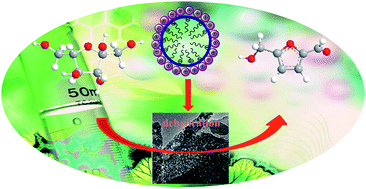Catalytic dehydration of fructose to 5-hydroxymethylfurfural over a mesoscopically assembled sulfated zirconia nanoparticle catalyst in organic solvent†
Abstract
The catalytic dehydration of fructose to 5-hydroxymethylfurfural (HMF) in DMSO was performed over a sequence of mesoscopically assembled sulfated zirconium nanostructures (MASZN) derived from zirconyl chloride with a template as a fastening agent. The materials were characterized by X-ray diffraction, FTIR spectroscopy, NH3 temperature-programmed desorption, pyridine FTIR spectroscopy, field emission scanning electron microscopy, transmission electron microscopy, and N2 sorption. The heterogeneous catalyst MASZN with Lewis–Brønsted acid sites had a superior performance in the dehydration of fructose to HMF. With MASZN-3 as catalyst, a HMF yield of 91.9% with a 98.5% fructose conversion was obtained at 110 °C for 120 min in DMSO. Finally, the catalyst MASZN-3 was recycled in four consecutive cycles with scarcely any loss of activity. The excellent catalytic properties together with its easy synthesis, low cost, and nontoxic nature make this MASZN a promising catalyst for the development of new and efficient processes for biomass-based chemicals.


 Please wait while we load your content...
Please wait while we load your content...